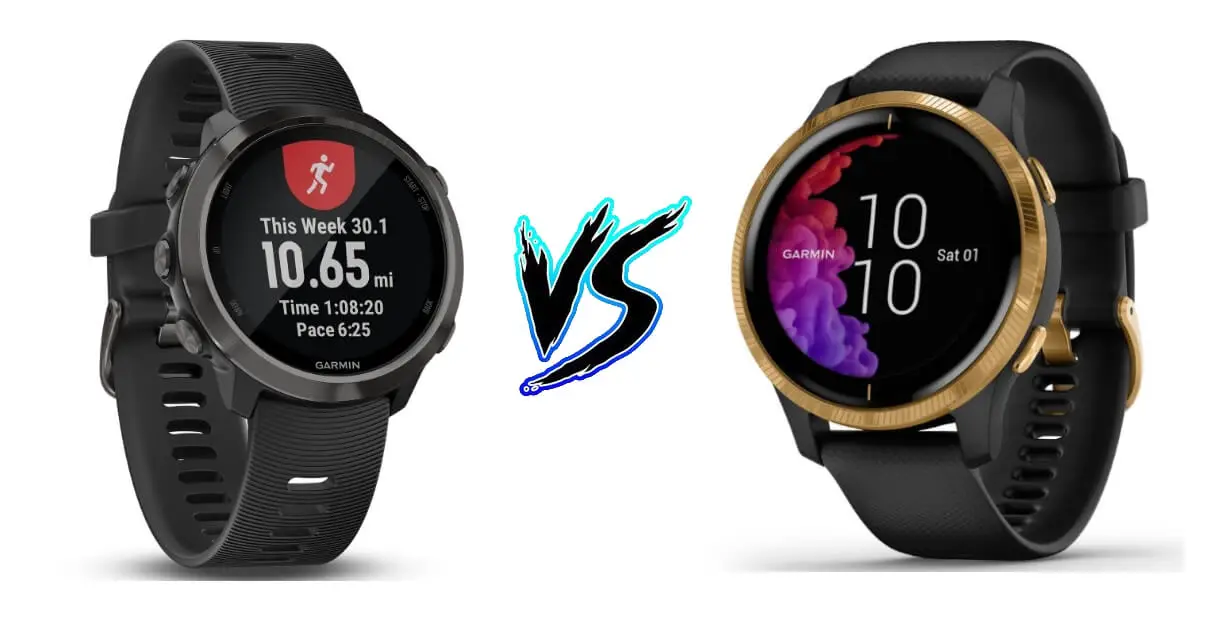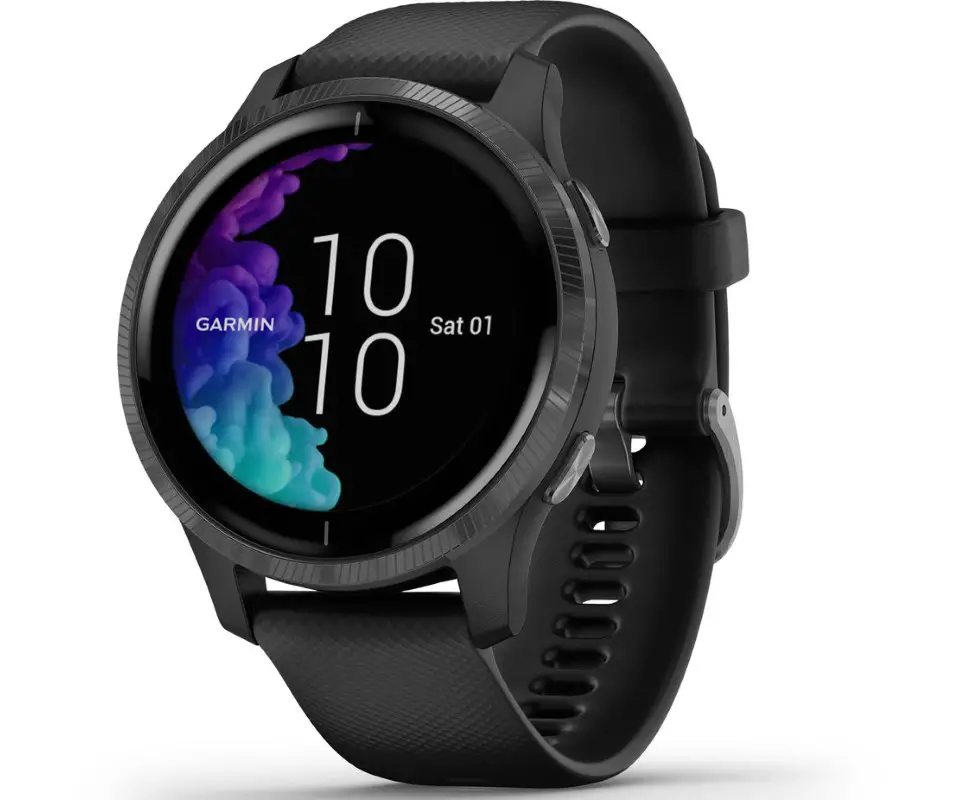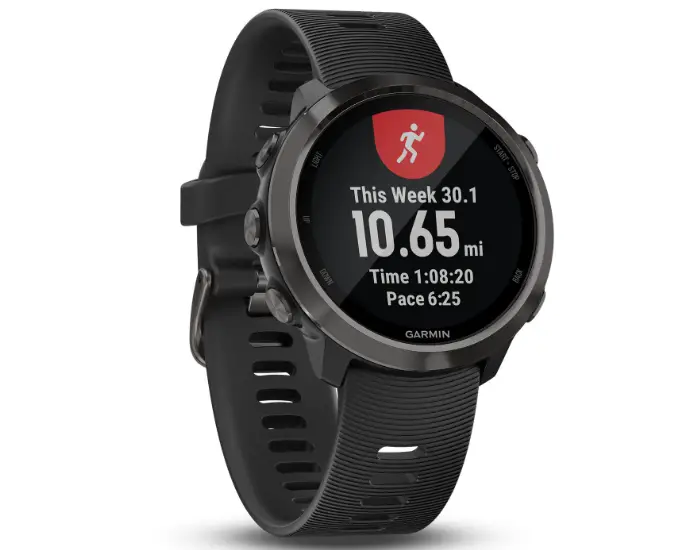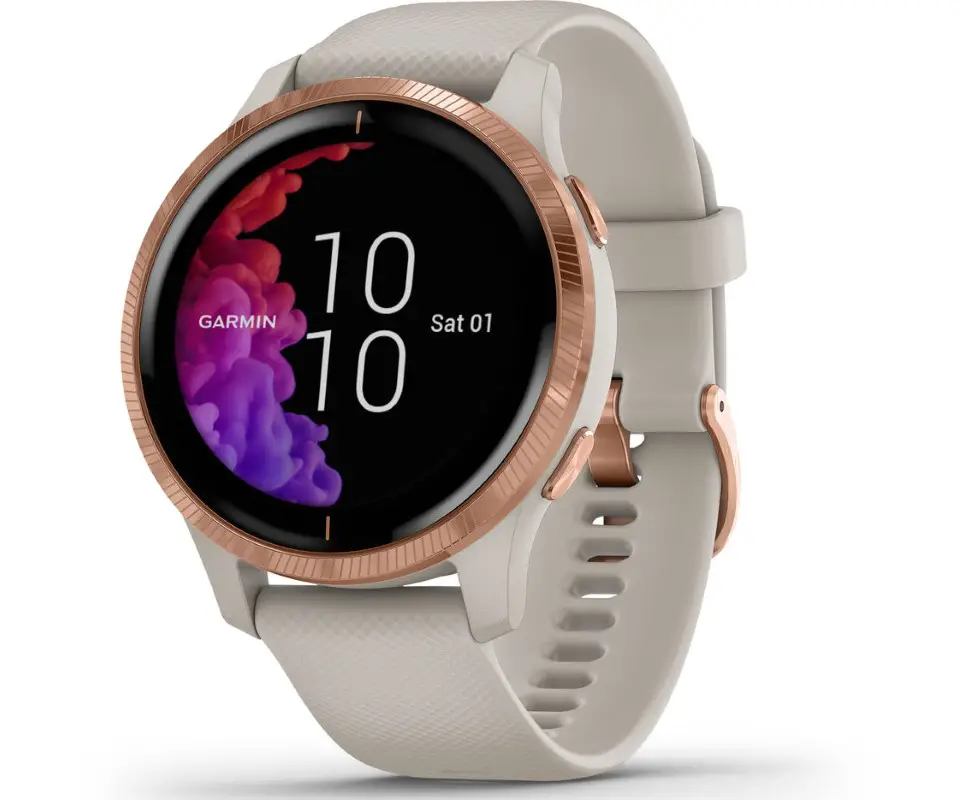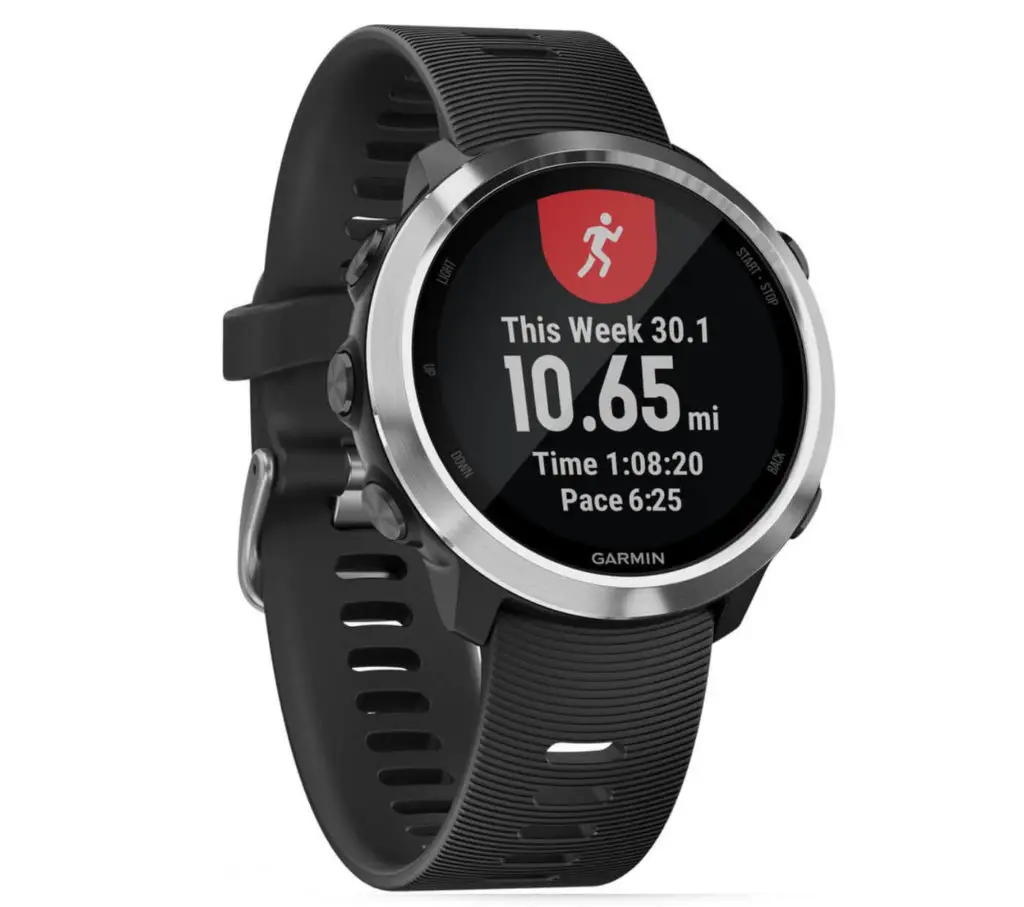The Forerunner 645 is one of Garmin’s best running watches. The Garmin Venu is one of the best activity trackers that Garmin has ever released. But which one is better to suited to your needs?
Because these watches share a bunch of different features like running, cycling, swimming and other sports modes, it can be quite tough to make a solid call. Hopefully, this post will help put your mind at ease by explaining all the key similarities and all the key differences, with a few simple recommendations at the end.
Let’s get started.
What are the main differences between the Forerunner 645 and the Garmin Venu?
- HD Touchscreen (Venu)– The Garmin Venu 4 has a touchscreen, whereas the Forerunner 645 relies exclusively on buttons to work the watch. That being said, some runners prefer a ‘button only’ setup.
- Advanced Running Dynamics (FR645) – Only the Forerunner 645 supports advanced running dynamics. This means real time access to cadence, stride length and other valuable running specific metrics.
- Garmin Running Power (FR645) – The FR645 supports Garmin running power, the Venu does not.
- Pulse Oximeter (Venu) – The Venu is built with Garmin’s latest optical heart rate technology, which includes a pulse oximeter to measure your blood oxygen levels.
- Body Battery Score (Venu) – Only the Venu includes support for Garmin’s body batter score. This is basically a holistic stat which combines your sleep data, training data and heart rate data into one unique metric.
- Golf Mode (Venu) – This is a big selling point for people who play 18 holes regularly. The Venu is basically an advanced activity tracker, that happens to double up as a dedicated golf watch.
- Guided Workouts (Venu) – There is no other Garmin which displays the on-screen guided workouts as well as the Venu. The screen is literally ideal for this purpose.
Forerunner 645 vs Garmin Venu - Key Similarities
Forerunner 645
Garmin Venu
Corning® Gorilla® Glass 3
Corning® Gorilla® Glass 3
Forerunner 645 vs Garmin Venu - Key Differences
Forerunner 645
Garmin Venu
1.2" (30.4 mm) diameter
1.3" (33.0 mm) diameter
240 x 240 pixels
390 x 390 pixels
42.5 x 42.5 x 13.5 mm
45.1 x 45.1 x 12.8 mm
42.2 g
50.5 g
19
20
7 Days
5 Days
14 Hours
20 Hours
5 Hours
6 Hours
Comparison of Sports Modes
| Forerunner 645 - Sports Modes | Garmin Venu - Sports Modes |
|---|---|
| 01) Strength Training | 01) Strength Training |
| 02) Cardio Training | 02) Cardio Training |
| 03) Elliptical Training | 03) Elliptical Training |
| 04) Stair Stepping | 04) Stair Stepping |
| 05) Floor Climbing | 05) Floor Climbing |
| 06) Indoor Rowing | 06) Indoor Rowing |
| 07) Yoga | 07) Yoga |
| 08) Running | 08) Running |
| 09) Treadmill Running | 09) Treadmill Running |
| 10) Indoor Track Running | 10) Indoor Track Running |
| 11) Skiing | 11) Skiing |
| 12) Snowboarding | 12) Snowboarding |
| 13) Cross Country Skiing | 13) Cross Country Skiing |
| 14) Stand Up Paddleboarding | 14) Stand Up Paddleboarding |
| 15) Rowing | 15) Rowing |
| 16) Cycling | 16) Cycling |
| 17) Indoor Cycling | 17) Indoor Cycling |
| 18) Pool Swimming | 18) Pool Swimming |
| 19) Walking Mode | 19) Walking Mode |
| 20) Golf Mode |
As you can seem from the comparison table above, the Forerunner 645 and the Garmin Venu are very similar from a sports tracking perspective. It’s really just the golf mode that gives the Venu the edge.
With that being said, the FR645 has much better running specific features, which will be explained in more detail below.
Main Reasons To Choose the Forerunner 645

1. It's much better suited to Running Specialists
At first, it might look like the Forerunner 645 and the Venu have similar running capabilities. But if you dig a little bit deeper, it should be become clear that the FR645 is much better equipped to satisfy the interests of serious runners. There are 2 big benefits that you gain, if you choose the Forerunner 645.
Running Benefit A - Advanced Running Dynamics
By opting for the FR645, you can gain access to 6 metrics that aren’t available with the Garmin Venu. These metrics are listed below.
- Ground Contact Time – The time your foot spends on the ground with each stride.
- Ground Contact Balance – Symmetry between left and right foot when running.
- Vertical Oscillation – The amount of ‘bounce’ in your running motion. Reducing the amount of bounce in your stride can improve your running efficiency/economy.
- Vertical Ratio – the cost-benefit ratio with stride length. This stat can help you find the ideal stride length for setting new a PB, in any distance.
- Cadence – Real time cadence metrics, displayed on your watch
- Stride Length – Real time stride length data, displayed on your watch
It is worth mentioning that in order to access these metrics, you need to invest in one (not all) of the following accessories:
Running Benefit B - Garmin Running Power
This is another key reason for runners to choose the Forerunner 645. When you invest in one of the accessories that opens up advanced running dynamics (Garmin HRM Run or Garmin HRM Tri or Garmin Advanced Running Pod), you also gain access to Garmin’s running power stats.
This is definitely a big win for runners, because the accessories needed to access running power with Garmin are significantly cheaper than the 3rd party alternatives (Stryd and Runscribe+ specifically). Also, running power is one of the most coveted stats in the business for good reason. It can help you:
- Improve your pacing
- Find your ideal power-to-weight ratio
- Improve your running technique
- Assess if your training is actually helping you become a better runner
2. You prefer Sports Watches that Don't Have Touchscreens
This a big deal for lots of sports people. While there is nothing wrong with the AMOLED touchscreen of the Venu, it can be easier to operate a button only watch like the Forerunner 645 when exercising. For this reason, hardcore sports people (especially runners, cyclists and swimmers) might find the Forerunner 645 a bit more practical in the long run.
Main Reasons To Choose the Garmin Venu
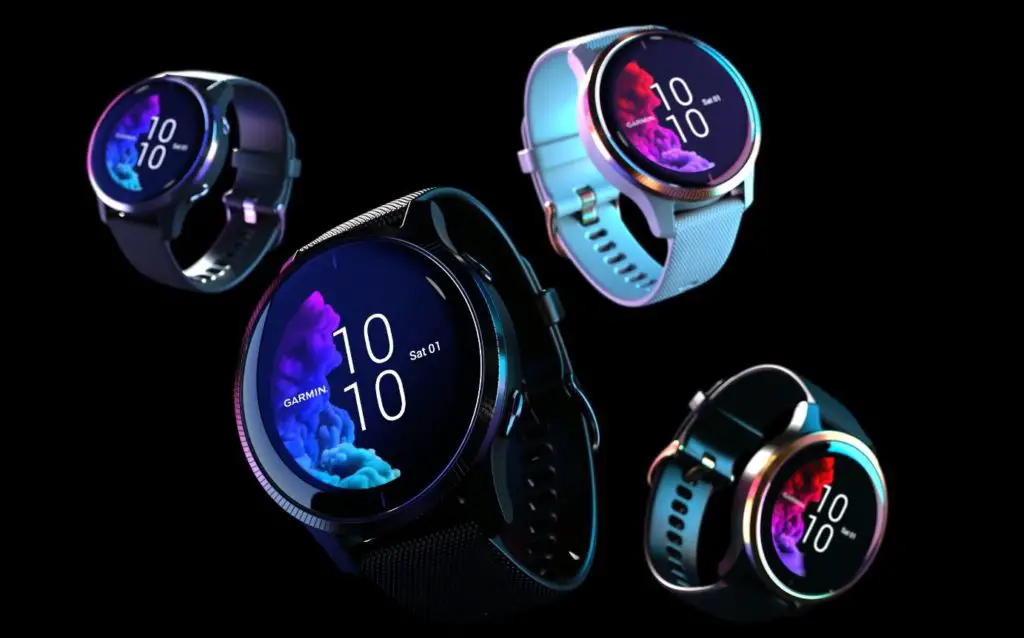
1. Gorgeous High Resolution Screen
Of all the Garmin sports watches that have ever been released, the Garmin Venu definitely has the best quality screen. It’s the first time they have introduced an HD AMOLED screen into their range, and we are glad to admit that it was worth the wait.
Long story short, the screen of the Venu is impressive, and significantly larger than the screen of the Forerunner 645. The bullet points below should further highlight the differences from a screen perspective:
- Forerunner 645 Screen Resolution: 240 x 240 pixels
- Garmin Venu Screen Resolution: 390 x 390 pixels
2. Guided On Screen Workouts
If you want access to guided workouts at the gym, the Garmin Venu will be much better suited to your needs. You literally gain access to a bunch of customized workouts, with a visual demonstration of each exercise in your overall workout.
This is one of the key reasons the Venu can be considered a better ‘Fitness Watch’ than the Forerunner 645. .
3. Pulse Oximeter (Blood Oxygen Measurement Device)
The Garmin Venu is built with Garmin’s latest optical heart rate moniter (Elavate V3) which includes pulse oximeter. The point of a pulse oximeter is to measure your blood oxygen levels. This is then used to help calculate your stress levels, body battery score and altitude acclimation if you exercise above sea level.
4. Body Battery Score
In Garmin’s own words, the whole point of the Body Battery Score is to “see your body’s energy levels throughout the day so you can find the best times for activity and rest.”
In other words, it’s basically an overarching statistic that combines sleep data, training data and heart rate date into one overarching metric than can help you assess your energy levels.
Unfortunately the accuracy of this statistic isn’t perfect, but it’s still a pretty cool feature and it can help you identify some lifestyle red flags if you do start pushing yourself a bit too hard, and don’t make time for adequate rest.
5. Touchscreen
This is a key difference between the Forerunner 645 and the Venu. While the touchscreen might not be quite as convenient when running or cycling, it is a lot more convenient during everyday use.
Basically, the Venu feels and operates like more of a Smartwatch, because of the large AMOLED touchscreen. Anyone who uses a Smartphone regularly will feel super comfortable when interacting with the Venu.
6. Dedicated Golf Mode
Naturally this feature is only relevant to golfers, but if you do play 18 holes regularly, this is a big drawcard for the Garmin Venu.
You essentially get an amazing fitness watch, that doubles as a dedicated golf watch. This includes yardage to the front, middle and back of the green, yardage to hazards, automatic shot distance tracking, a digital scorecard, and the option view the shape of the green.
All in all, this could be a compelling reason to choose the Garmin Venu if you’re big into golf.
Final Thoughts
In the end, it comes down to this.
Go for the Forerunner 645 if:
- You’re big into running
- You don’t like sports watches with touchscreens
Go for the Garmin Venu if:
- You want the more well rounded sports watch
- You want a high quality HD touchscreen
- You’re big into fitness and you want access to the guided workouts
- You want the more competent activity tracker with Body Batery Score and a Pulse Oximeter
You might also be interested in...
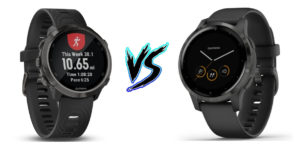
Garmin Forerunner 645 vs Garmin Vivoactive 4 – Comparison
The Forerunner 645 is one of Garmin’s best running watches. The Vivoactive 4 is arguably the best activity that Garmin has ever released. But which
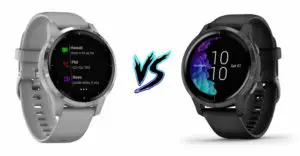
Garmin Vivoactive 4 vs Garmin Venu – Product Comparison
This is a simple product comparison between the Garmin Vivoactive 4 vs Garmin Venu. Of all the Garmin’s that have ever been created, these two

